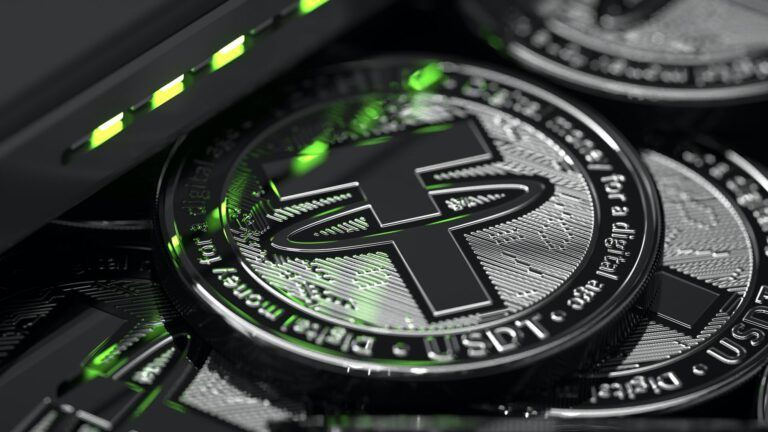
USDT vs USDC: A Look at the Leading Stablecoins
July 30, 2022Stablecoins have become a major part of the cryptocurrency space over time, with Tether USD (USDT) and USD Coin (USDC) now being the two leading stablecoins by market capitalization. While both are fully collateralized stablecoins, their underlying business models and infrastructure differ.
Looking at the differences between USDT and USDC is crucial for investors to decide which stablecoin they feel more comfortable with, and which they prefer to hold during periods in which they choose to sit on the sidelines.
During periods of heightened volatility, cryptocurrency investors have been known to move away from BTC and into stablecoins as cryptocurrency prices plunge. In June 2022, for example, CryptoCompare’s Exchange Review showed that after BTC lost 37.4% of its value in one month, Bitcoin spot trading into stablecoins rose last month as investors remained cautious.
What is Tether USD (USDT)?
As of July 2022 Tether USD (USDT) remains the largest stablecoin with a market capitalization of over $65 billion and dominates over 50% of the stablecoin market. It’s the most popular trading base pair for almost all crypto tokens and coins in crypto exchanges.
USDT has a 1:1 peg with the US dollar and is allegedly backed by a wide array of collateral reserves, including cash, commercial paper and commodities. The rationale behind this is to safeguard investors from volatility: in case of massive USDT liquidations, Tether can rely on those reserves to defend the peg with the US dollar.
History Behind USDT
Ifinex Inc —a Hong Kong-based company founded in 2014— is the owner of Tether Limited, the company in charge of issuing USDT. Like many other stablecoins, USDT was designed to bridge the gap between fiat and cryptocurrencies, allowing users to exchange their crypto for a stable currency such as USD.
USDT was originally an ERC-20 token on the Ethereum network, but it’s now compatible with other networks such as TRON and the BNB Chain. There’s also a Euro-pegged version of Tether (USDT-EUR) and two soon-to-be-released sterling-pegged and Mexican Peso-pegged versions of USDT.
Tether has also launched a gold-backed stablecoin called Tether Gold (XAUT). XAUT is backed 1:1 by physical gold, with each token representing “ownership of one troy fine ounce of physical gold on a specific gold bar” held in a Swiss vault.
Tether frequently updates its USDT reserves holdings on its website. On June 22, Tether’s chief technology officer Paolo Ardoino said the firm is “open to providing more information” about USDT and the current status of the company, the reason why Tether will soon undergo an audit from a “top-12 accounting firm” though the exact date is unknown.
USDT wasn’t the first stablecoin as many people believe —it was one of the early ones in the crypto space, launched as RealCoin in July 2014 and later rebranded to Tether in November of that year.
USDT plunged to $0.95 on May 13, shortly after the Terraform Labs collapse. A day after it was trading at $1 again. Tether said they were able to process $3 billion in withdrawals, calming investors’ fear of Terra-like depeg.
Tether Controversies
Tether didn’t become the behemoth that it’s today without controversies. Here’s a quick rundown of the stablecoin issuer most popular controversies:
- November 2017: a hacker steals $31million worth of USDT tokens on the Tether platform, leading to a hard fork shortly after the incident. At the time, critics and detractors were already slamming Tether for its lack of communication of its reserves, and federal investigations would follow.
- January 2018: Tether hires an accounting firm to perform an audit but soon dismisses it. Tether soon developed premiums for BTC/USDT as investors feared an USDT collapse.
- October 2021: The company had to pay the Commodity Futures Trading Commission (CFTC) a $41 million fine due to “misleading statements and omissions” about its collateral reserves.
- July 2021: The US Department of Justice accused Tether executives of alleged bank fraud.
What is USD Coin (USDC)?
USD Coin (USDC) is the second-largest stablecoin by market capitalization, with over $54 billion as of July 2022. Centre —a consortium co-founded by Circle, Coinbase and other FinTech companies— is the issuer of USDC. Besides Ethereum, USDC is also compatible with other cryptocurrency networks, including Solana, TRON, BNB Chain, Stellar and Algorand.
Each USDC is pegged 1:1 with the US dollar and backed by cash and dollar-equivalent assets. These assets are held in different accounts with U.S. financial institutions, and Grant Thronton International, a major auditing firm oversees these assets.
Circle is a financial technology company that founded Centre, a consortium composed of other notable crypto companies in the industry including crypto exchange Coinbase and BTC mining company Bitmain.
USDT vs. USDC: What Are Statistics Saying?
Both USDT and USDC have been successful in providing users with long-term stability. However, while Tether remains the number one stablecoin with the largest market cap in the market, it seems its share dominance has been in macro decline since 2020.
Tether’s decline has been attributed as a result of the constant accusations of misleading investors, providing financial regulators with unclear information, and generally a lack of transparency regarding its reserves. Therefore, investors might be prone to choose USDC over USDT.
USDC debuted in 2018 and quickly became one of the most popular choices for investors. The token has managed to maintain itself out of controversies in the industry mainly due to the fact that Circle constantly attests USDC’s reserves and runs annual audits. Circle files these audits publicly with the Securities and Exchange Commission
USDT vs USDC: Comparing Reserves
In short, here’s how both companies back their stablecoins:
- USDT: diverse mix of: cash, cash-equivalents, commercial paper (which is short-term corporate debt —as of mid-2022, Tether has been reducing its commercial paper holdings until eventually removed from reserves), commodities, loans, digital currencies and other investments.
- USDC: cash and short-term U.S. Treasury bills.
Stablecoins: Use Cases
Stablecoins have several use cases, let’s see the most popular and basic ones:
- Stablecoins allow users to exchange their crypto assets for dollar-pegged tokens and therefore protect them during times of heightened volatility.
- Stablecoins function 24/7, so settlement times are much faster and transactions cheaper compared to banks.
- Companies can pay workers in USD-pegged stablecoins. Employees can then trade stablecoins in a peer-to-peer fashion for fiat currencies or crypto assets through a crypto exchange such as Binance. One of the first non-crypto companies to pay workers with USD-pegged stablecoins was Nippon Yusen K.K., one of Japan’s largest shipping lines.
- Moreover, stablecoins play important roles in the DeFi ecosystem: They power decentralised applications (dApps) as these can accept USDT or USDC, for example, as a form of payment instead of receiving volatile coins like Bitcoin or Ether.
- Several DeFi protocols allow users to generate high-yield opportunities on their crypto assets using stablecoins. These yields are considerably higher —over 10% in annual percentage yield (APY)— than any bank’s interest-bearing account.
What Types of Stablecoins are There?
We have three main types of stablecoins: crypto-backed, fiat-backed and algorithmic stablecoins.
Fiat-backed stablecoins
Fiat-backed stablecoins are the ones like USDT and USDC, having cash reserves or a mix between cash, dollar-denominated assets, and other cash equivalents. There are also commodity-backed stablecoins, backed by gold, oil, or other commodities.
Crypto-backed stablecoins
Cryptocurrency-backed stablecoins have some form of cryptocurrency as reserve, but are over-collateralized in order to defend their peg. This means that the collateral should exceed the stablecoin supply. One popular example is DAI, Maker Protocol’s flagship stablecoin, backed by Ethereum and other crypto assets
Algorithmic stablecoins
Algorithmic stablecoins rely on code to keep the parity, usually through a burning mechanism. A popular algorithmic stablecoin was Terra USD (UST). UST relied on arbitrageurs, traders that profit from price discrepancies, who’d buy UST when it traded below $1 and sell it for $1 worth of LUNA, its sister token, therefore shrinking UST supply and increasing its value.
Conversely, arbitrageurs would mint UST by burning LUNA, returning UST to $1 while shrinking the LUNA supply, at least theoretically, increasing LUNA’s value. The algorithmic stablecoin collapsed after a large withdrawal on a decentralised exchange with low liquidity triggered a bank run.
Because of the algorithmic system behind UST, trillions of LUNA were printed while the stablecoin’s value kept on dropping. Other algorithmic stablecoins rely on similar systems and remain pegged to the value of the U.S. dollar, including USDD.
Stablecoin Regulation in the U.S. and Worldwide
Stablecoin regulation has been ramping up worldwide as more governments look into the benefits of digital currencies and how they can improve the payments system. Another factor is the collapse of numerous crypto lenders and stablecoin issuers in the last few months, such as Terra, Celsius, and Three Arrows Capital (3AC).
On one hand, the US is working on stablecoin legislation expected to become law by the end of the year, according to a Biden official. The bill will introduce bank-like regulation and oversight for stablecoin issuers, including sufficient capital, liquidity and supervision.
On the other hand, the UK’s secretary of treasury said stablecoins like USDT or cEUR are reliable cryptocurrencies that can enhance virtual payments. However —just like most governments— the UK is still keen on controlling stablecoins with its Financial Services and Markets Bill.
Image Credit
Featured image via Unsplash
Source: Read Full Article


